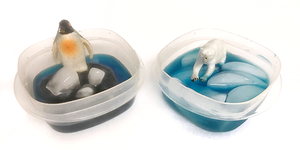Ocean Sciences STEM Activities for Kids (5 results)
About 70% of Earth's surface is covered by oceans but humans have only explored 5% of the ocean! From microscopic phytoplankton to pods of whales and global weather patterns there is a lot left to discover.
|
Select a resource
Sort by
|
STEM Activity
48 reviews
Have you ever noticed that if you leave an ice cube out on the kitchen counter and come back to check on it in a while, you find a puddle? The same thing happens to ice in nature — if the temperature gets warm enough, the ice melts. In this science activity, you will explore what happens to sea levels if the ice at the North Pole melts, or if the ice at the South Pole melts. Does melting ice at either cap contribute to a rise in sea levels? It is an especially important question for…
Read more
STEM Activity
88 reviews
Have you ever wondered why some objects float on top of the ocean, and other objects sink to the bottom? It has to do with the density of the objects compared to the density of the salt water surrounding them in the ocean. If you add salt to plain water, it increases the density of the water. In fact, if you add enough salt, you can make the water so dense that an egg will actually float in it! Explore how this works in this science activity.
Read more
STEM Activity
1 review
A day at the beach is a wonderful way to spend time with your family and friends. You can swim, play games and build sand castles. But have you ever wondered how the beach you are standing on came to be? How, for example, did all of that sand get there? Beaches are formed and continually changed by the ocean's waves moving rock particles onshore, offshore and along the shore. In this activity, you can investigate how beach formations are made by some parts of a beach that can resist erosion…
Read more
Featured
STEM Activity
60 reviews
Did you know that the seaweed you've seen in the ocean or even eaten as a snack is inspiring innovators to imagine new materials? Large
brown algae, like kelp, contains polymers—long chains of molecules—that are more environmentally friendly than the ones in most plastics. These natural polymers (alginates) could eventually be used to create sustainable everyday objects. Try your hand at using a bit of chemistry to turn biodegradable polymers from algae into your own custom…
Read more
STEM Activity
You probably know that water never stays still. But did you know that there is something called the global “ocean conveyor belt” that moves massive amounts of water from one ocean to another? These water currents are essential for mixing and transporting nutrients and oxygen, and play a critical role in our climate. This is because they move warm and cold water over very long distances, which affects the temperature of the landmasses that border the ocean. The Gulf Stream, for…
Read more
STEM Activity
Have you ever wondered what causes ocean currents? Ocean currents have profound effects on the climates of the continents, especially those regions bordering on the ocean. For example, it’s thought that the Gulf Stream (a warm current around the North Atlantic Ocean) makes northwest Europe much warmer than it would otherwise likely be. In this science activity, you will model the behavior of these “rivers” of hot and cold water within the ocean to find out how temperature…
Read more
|
Explore Our Science Videos
Make Candy Gears - STEM activity
Build A Solar Updraft Tower!
Storm Surge Activity - Protect Houses From Waves








